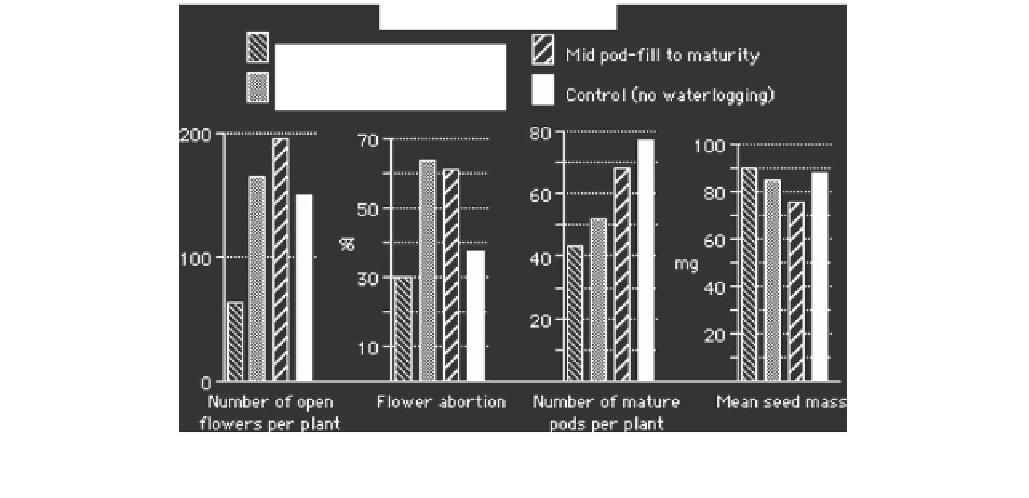Agriculture Reference
In-Depth Information
Period of Water logging
Emergence to first flower
Mid pod-fill to maturity
First flower to mid pod-fill
Control (no water logging)
80
200
70
100
80
60
50
60
%
40
100
mg
30
40
20
20
10
0
Number of open
flowers per plant
Flower abortion
Number of mature
pods per plant
Mean seed mass
FIGURE 9.4
Effects of the timing of waterlogging on components of cowpea (
Vigna unguiculata
) yield.
(Data from Minchin, F. R.,
R. J. Summerfield, A. R. J. Eaglesham, and K. A. Stewart. 1978.
Journal of Agricultural Science
90: 355-366.)
D
RAINAGE
S
YSTEMS
W
ETLAND
-A
DAPTED
C
ROPS
Drainage systems have long been employed to remove
excess water from the root zone of crops and to prevent
flooding of farmland. By lowering water levels or pre-
venting flooding, the soil ecosystem is kept aerobic,
promoting healthy root systems and leading to
increased yields. Drainage systems are known to have
been used by Roman and Chinese farmers over 2000
years ago. Much of the Yangtze River Valley of China,
the lowlands of The Netherlands, and the Delta region
of California would not be farmable without complex
drainage systems.
Drainage systems involve the construction of
levees, canals, and ditch systems that either keep low-
lying areas from being flooded or permit the water table
to be lowered so that cropping can take place. In some
locations with saturated soils, mounding or raised
beds are used. More recently, stricter control of soil
moisture has become possible with the development of
subsurface drainage systems employing perforated
plastic pipe that can be laid with special trenching
machines.
But drainage systems are not without costs. Apart
from the economic costs of installation and maintenance,
drainage systems have ecological costs. The removed
water carries with it nutrients and sediments that are lost
to the system and must be replaced. In areas of variable
rainfall, excess drainage can cause increased drought dam-
age during a dry year. In some regions with high evapo-
transpiration (ET) during the growing season and where
drains are used extensively, the disposal of the drainage
water itself can be a problem, especially, when it carries
pesticide residues and high salt loads that can damage
nearby natural ecosystems.
Instead of treating flooding as a problem to be solved with
drainage systems or other infrastructures, it can be viewed
as an opportunity for growing crops with adaptations that
allow them to tolerate waterlogging. Rice (
Oryza sativa
)
is probably the most well-known example of such a crop.
Originally, an aquatic or swampland plant, rice has been
cultivated as a crop that flourishes in wet habitats. Its
adaptations include special air-space tissue in the stems
that allow air to diffuse to the roots, roots that can grow
under conditions of low oxygen concentration, the ability
to oxidize ferrous ions to reddish brown ferric hydroxide
in the rhizosphere and thus tolerate soils with high redox
potential, and seeds that will germinate underwater due to
their low oxygen requirement. Other crops are not com-
pletely wetland-adapted, yet have adaptations that allow
them to tolerate periodic flooding. Taro (
Colocasia escu-
lenta
), for example, may be able to tolerate flooding
because of its ability to store oxygen in the swollen corm-
like base of the leaves.
A
GROECOSYSTEM
-
LEVEL
A
DAPTATION
TO
E
XCESS
S
OIL
W
ATER
When an agroecological focus is applied to coping with
excess water, an intermediate approach is taken. Rather than
trying to eliminate the water or restricting production to
waterlogging-adapted crops, various forms of traditional
raised-field agriculture can be used. In areas with a high
water table or periods of inundation, topographic variation
in soil levels is created. Soil is dug to build up raised beds,
and in the process, canals or ditches are formed, which can
also serve for drainage, if too much water enters the system
at some time of the year. But the main purpose of the ditches




Search WWH ::

Custom Search